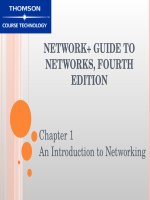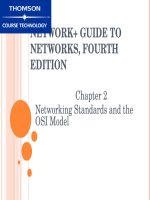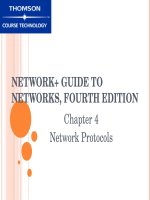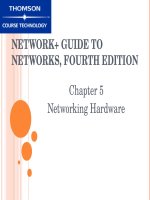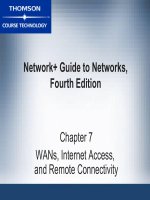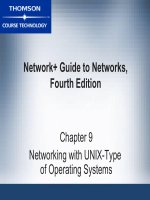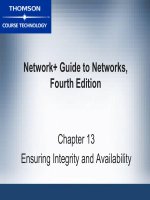Guide to network essentials 4th chapter 10
Bạn đang xem bản rút gọn của tài liệu. Xem và tải ngay bản đầy đủ của tài liệu tại đây (1.16 MB, 58 trang )
Chapter 10:
Network Administration
and Support
Learning Objectives
Manage networked accounts
Enhance network performance
Create a network security plan
Protect servers from data loss
Guide to Networking Essentials, F
2
Network Administration
Network administration involves many areas:
Ensure
network performs to specifications
Verify users can easily access resources they are
authorized to use
Monitor network traffic
Be responsible for security issues
Critical area is managing user accounts and
groups
Set
permissions and grant rights
Guide to Networking Essentials, F
3
Managing Networked Accounts
Users should be able to access resources they
are allowed to access
Prevent users from accessing resources they do
not have permission to access
Many ways to assign permissions
Principles
are same, but details differ
NOSs have user management utilities
Guide to Networking Essentials, F
4
Creating User Accounts
Windows has two predefined accounts:
Administrator
– used to manage network;
should create strong password and guard
account; good idea to rename it; account
cannot be disabled
Guest – for users without personal accounts
Guide to Networking Essentials, F
5
Creating User Accounts (continued)
Must make decisions before creating other user
accounts:
User
Names – how many letters
Passwords – when to change, what restrictions
on reusing same password, how to handle
account lockouts
Logon Hours – what restrictions
Auditing – what to track
Security – secure network protocol required or not
Guide to Networking Essentials, F
6
Passwords
Users should change passwords for security
If
require changes too frequently, users may
forget password
Can set restrictions about when old password
may be reused
Combine upper and lowercase letters since most
passwords are case sensitive
Include
numbers or punctuation and special
characters to prevent dictionary attacks
Guide to Networking Essentials, F
7
Passwords (continued)
Limit number of times user may enter wrong
password before account is locked
Longer passwords are better
Different NOS have different maximum character
limitations for passwords:
Windows
2000/2003 limit is 128 characters
Windows NT limit is 14 characters
Linux limit is 256 characters
Guide to Networking Essentials, F
8
Logon Hours
Can restrict logon hours by time, day, or both
Prevents
intruder break-in after working hours
Determine what happens when user is logged in
and authorized time expires
Can
disconnect user or just prevent connection
to new resources
Guide to Networking Essentials, F
9
Auditing
Records certain actions for security and
troubleshooting
Can
log only failed access attempts or all
accesses
Should use auditing sparingly
Can
adversely affect availability of system resources
Guide to Networking Essentials, F
10
Setting User Rights
Simplify network administration by assigning rights to
groups
Two general kinds of groups:
Local groups – use only single machine
Table 10-1 shows rights assigned to default local
groups for Windows 2000/2003
Global groups – use within or across domain
boundaries
Universal group is new type beginning with Windows 2000
Users may belong to more than one group
Guide to Networking Essentials, F
11
Windows 2000 Server Default Local
Groups
Guide to Networking Essentials, F
12
Setting User Rights (continued)
Some group memberships are automatic
See
Table 10-2
All users belong to Everyone group
May want to change rights
In
Windows NT, changes written to Registry in files
Security and Security Accounts Manager (SAM)
In Windows 2000/2003 servers, changes written to
Active Directory database
Guide to Networking Essentials, F
13
Windows 2000 Automatic Groups
Guide to Networking Essentials, F
14
Managing Group Accounts
Can add and delete rights for groups
Can nest groups within other groups
Windows
2000/2003 must use native mode to do so
Local groups can include global groups, but not
vice-versa
Allows
cross-domain communication
Trust relationship is when members of one
domain access resources in another domain
Guide to Networking Essentials, F
15
Trust Relationships
Manage cross-domain communications
In
Windows NT, must use Trust Relationships
dialog box to create trusts
For Windows 2000/2003 servers, trust relationships
automatically extend to interrelated domains
Three types of trusts:
One-way
trust
Two-way trust
Universal trust
Guide to Networking Essentials, F
16
Disabling and Deleting User Accounts
Windows 2000/2003 has two options to make
user account inactive:
Disable
it – temporarily turning account off; retains all
assigned rights and may be restored
Delete it – removes account completely
Cannot disable or delete Administrator account
In Linux, a user account can be disabled by
editing the password file and deleted by using
the userdel command
Guide to Networking Essentials, F
17
Renaming and Copying User Accounts
Two options when new user replaces existing user:
Rename
old account – must change password
In Windows 2000/XP Professional, use Users and
Passwords utility, shown in Figure 10-1
In Windows 2000 Server, use Active Directory Users
and Computers management console, shown in
Figure 10-2
Copy old account into new one with different
username; then disable old account
Guide to Networking Essentials, F
18
Users and Passwords Utility
Guide to Networking Essentials, F
19
Active Directory Users and Computer
Management Console
Guide to Networking Essentials, F
20
Managing Network Performance
Monitor these parameters:
Data
read from and written to server each second
Queued commands
Number of collisions per second on Ethernet network
Security errors
Connections currently maintained to other servers
(server sessions)
Network performance
Guide to Networking Essentials, F
21
Network Performance
Three tools monitor system performance in
Windows server and professional versions
Event
Viewer
Performance Monitor
Network Monitor
Numerous open source and shareware
utilities for Linux servers
Guide to Networking Essentials, F
22
Event Viewer
Event Viewer creates three log files:
System
Log – records information about operating
system services and hardware
Security Log – records security events based
on audit filters or policy settings
Application Log – maintains information about
applications
Guide to Networking Essentials, F
23
Event Viewer (continued)
With Active Directory, Event Viewer creates
three more logs:
Directory
Service
DNS Server
File Replication Service
Guide to Networking Essentials, F
24
Performance Monitor
Records individual events to show trends
Keeps track of certain counters for system objects
Object
is portion of software that works with other
portions to provide services
Counter is part of object that tracks particular aspect of
its behavior
Figure 10-4 shows % Processor Time and
% Interrupt Time per second
Guide to Networking Essentials, F
25
